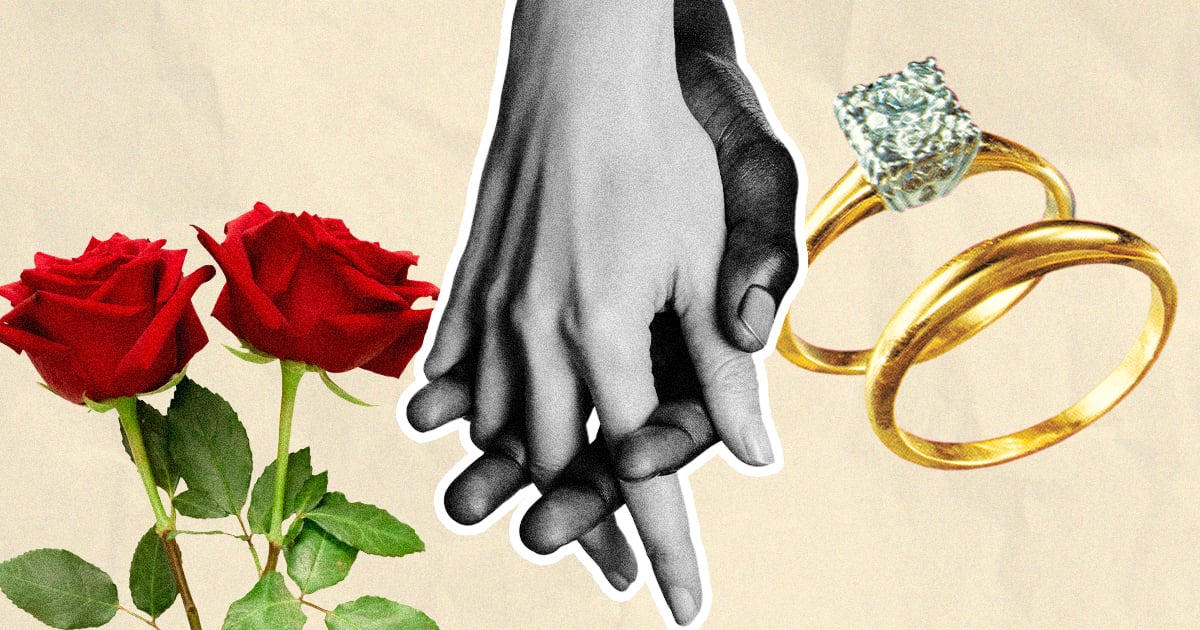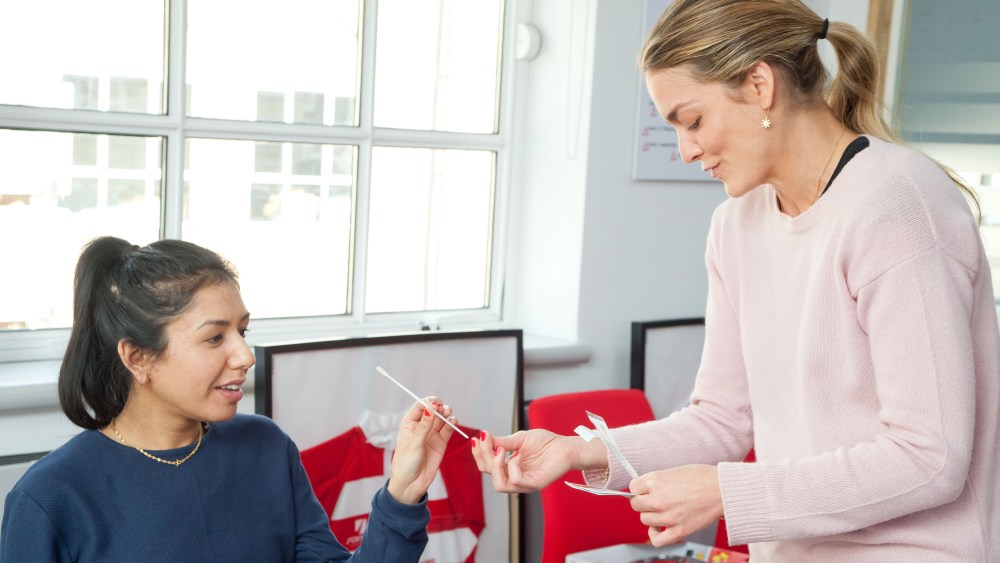I knew I wanted to marry my now-fiancé, Kelsey, after four months of dating. Thus, when she finally asked the question 1,628 days – but who’s counting? – later, it was an easy yes. The hard part was proposing back. That took me a full five months to figure out.
My delay mostly hinged on a (somewhat) irrational fear of not living up to hers, which, to be fair, was the stuff of rom-coms: Kelsey dropped to one knee at sunset on a private beach in the Philippines, cotton candy skies and palm trees as our witness, followed by a candlelit dinner at our overwater villa where we sipped Champagne and danced to a song she wrote and commissioned. With my own proposal, I wanted her to feel even a morsel of what I did in that moment: a mix of sound and silence, of lightning bolts and Enya.
Anyway. What’s the human equivalent of breathing into a paper bag, without the bag? That was me come time to propose back. It was early February, and I had planned a series of unfolding surprises, starting at our first date spot and ending with an intimate musical performance in the back of a speakeasy. Family and friends flew in from across the country, popping in sporadically as the evening unfurled, including guitarist for rock band Incubus Mike Einziger and master violinist Ann Marie Einziger – also, founders of skin-care brand Mother Science – who serenaded us well into the evening.
When I looked over at her, with everyone we love scream-singing “Drive” around us, it became worth every stress-text, all the coordinating of logistics, the countless reservations made (then canceled, then made again). It was bliss. To me, proposing back was less about the spectacle and more about what it stood for: equal partnership in everything ahead. It mattered to me that she have just as much of an opportunity to say “yes” to the proposition of marriage as I did. Reciprocation matters. It will always matter.
I do realize, for most couples, this scenario is unfamiliar. In fact, in many relationships, a double proposal is not the norm – only 1 percent of heterosexual couples and 8 percent of LGBTQ+ couples had joint proposals in 2023, according to a recent study by wedding website and vendor marketplace The Knot – but it should be. Marriage isn’t a one-person rodeo, after all. So, why is the whole engagement process?
More importantly: can we finally reconsider this age-old tradition?
Experts Featured in This Article:
Nicole Moore is a relationship expert, love coach, and host of the TV show “Reality of Love.”
Edward Perotti is an award-winning designer and celebrity event planner.
The Background on Double Proposals
Personally, I’d never heard of any of my friends in hetero relationships proposing back to their partners, but within the queer community, it’s far more common. This makes sense given the archaic history of marriage, where the decision of whom to marry was placed on the man as a way to impose traditional gender norms, says relationship expert Nicole Moore.
“As it was assumed that men were the providers and women wouldn’t work, it became customary for men to propose marriage when they felt financially ready to provide for a woman. Even after the feminist movement and women entering the workforce and finding empowerment outside of the home, the custom of the man proposing marriage stuck around, perhaps because old habits can be hard to break.”
Those in non-heterosexual relationships, on the other hand, have always been excluded from those conversations around marriage, and therefore the societal conventions that followed. When there are two men, two women, two gender non-conforming folks, or any other combination that steps outside of the heteronormative standard, the “rules” don’t exactly apply. (Lest you forget, same-sex marriage was illegal in all 50 states until 2015.)
This “gave them more freedom to experiment outside of the norms and discover what kind of partnership and proposal would truly make them happy,” Moore says. “Since proposing in such a dynamic was symbolic rather than legal, it actually gave way to some of the more heartfelt proposals because it truly was all about love and not about legal or economic benefit.”
How Common Are Double Proposals?
These days, its prevalence is harder to quantify. Celebrity planner Edward Perotti, who has designed approximately 2,000 events over the past several decades, notes that reproposals in the US are not particularly common, but do take place. He typically gets asked to plan a “take two” event three to five times a year. “This is not happening as much as one might think, but with social media, it appears to be a much larger trend,” he says.
Still, while data from The Knot indicates that just 8 percent of queer couples had joint proposals, and even less for hetero couples, there seems to be some reciprocation: according to the same study, nearly 30 percent of LGBTQ+ couples exchanged two rings within the engagement period in 2023. (When, exactly, they were exchanged was not clear.)
In some countries, this is customary across all relationships. If you’ve ever watched the Brazil edition of Netflix’s “Love is Blind” series, you may have noticed both parties exchange rings during the proposal. This is also the case in Sweden, Moore says, where it’s typical that an engagement is seen as a joint decision by the couple.
However, this is typically the exception, not the rule. Petition to change that?
A Case For Proposing Back
Look, traditions can be fun: buying someone cake for their birthday, tailgating the football game, eating mashed potatoes on Thanksgiving. But this one, in my opinion, is worth flipping on its head. It’s not about gender or who “wears the pants” in the relationship; it’s about the shared autonomy over choosing your partner for life.
“The beauty of being outside of the box is the freedom to choose your own adventure, which also has the benefit of inspiring others to the alternative ways of proposing,” Moore says.
Image Source: Kelsey Castañon
I’ll acknowledge I’m partial when I say Kelsey deserves every crumb the world will offer, but I’d like to believe anyone agreeing to marry someone else thinks that person is deserving of the extra thought. That’s what proposing back to your partner symbolizes: equality in the relationship, consideration for the other person, and one more chance to bask in the excitement of your future together.
Bonus? It’s about as low-pressure as proposing goes. There’s zero risk of rejection because you already know they want to marry you, so it becomes more about what the moment represents.
It’s also never too late to ask. For Perotti, his proposal back to his husband will come on the couple’s 20-year anniversary. “His original proposal was perfectly tailored to my preferences – Paris, midnight, full moon, on a bridge over the Seine – and because of this, I’ve been contemplating the idea of a vow renewal,” he says. “This time, I plan to propose to him, and I’m excited to create a moment that reflects his preferences: family, travel, fashion.”
In the end, the details are superfluous. It doesn’t matter who goes first, how big (or small) you make it, or – in my case – how long it takes. You’ll never regret making the person you love feel special, and chances are it will never, between now and till life do you part, be easier to do that than by asking a simple question.
Kelsey Castañon is a Brooklyn-based writer, editor, and content strategist with more than 13 years of experience in publishing. She is currently the senior content director at POPSUGAR, where you can find her stockpiling (and reporting on) everything from skin care to wine. Previously, she has worked with the teams at Refinery29, Seventeen, Shape, Allure, and Teen Vogue, and has appeared on TV segments on “The Dr. Oz Show” and “Good Morning America.”



